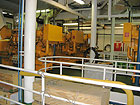

 | |||||||||||||||||||||
|
|
Journals 2007/2008Mark Goldner
December 5, 2007 55° 28' S, 64° 27' W Today was the last "science day," We've just completed the last CTD cast, and now we take the 28-hour or so steam back to Punta Arenas. The weather today has been glorious, a nice day to spend out on deck. Last night things got pretty rough again; in fact, we had to delay doing any CTDs for over 8 hours because of rough seas. But things calmed down quickly this morning. For those who might be following the course of the boat carefully, late tonight we'll retrace our steps back through the Strait of la Mer and then North to the Magellan Strait. We'll probably get the East end of the Magellan Strait sometime very late Thursday night or Friday morning. At some point we pick up the "pilot" for the last several hours of the trip. The pilot is someone employed by the government of the port city where you are coming or going from, someone who knows the waters around the port well, and can help be a navigator for the ship's captain.
Today the guys in the engine room gave us a tour of the engine room, showing us the inner workings of engines, generators, water systems and control room. Richard Johnson led us on a tour of that part of the ship. Richard has 30 years experience working on various ships! Jerry Lakarnafeaux and David Monroe (the chief engine operator) were also on hand to answer many of our questions. It was really quite impressive to see the four giant diesel engines (total of 12,700 HP!), and the 4 giant generators. The four engines are used to drive two large "screws". These are enormous shafts that in turn are used to move 13-foot blades. The type of system on this ship keeps the shafts rotating at a constant rotation rate of 900 RPM. To adjust the thrust power, the angle of the blades is adjusted.
We also got to see the enormous generators that supply power to the ship. In addition, we saw the water purification system and wastewater treatment system. This ship produces about 3000 gallons of water a day, by evaporating saltwater to remove the salt. We learned that the wastewater is simply treated by an electrochemical process and then dumped into the sea.
|
||||||||||||||||||||




